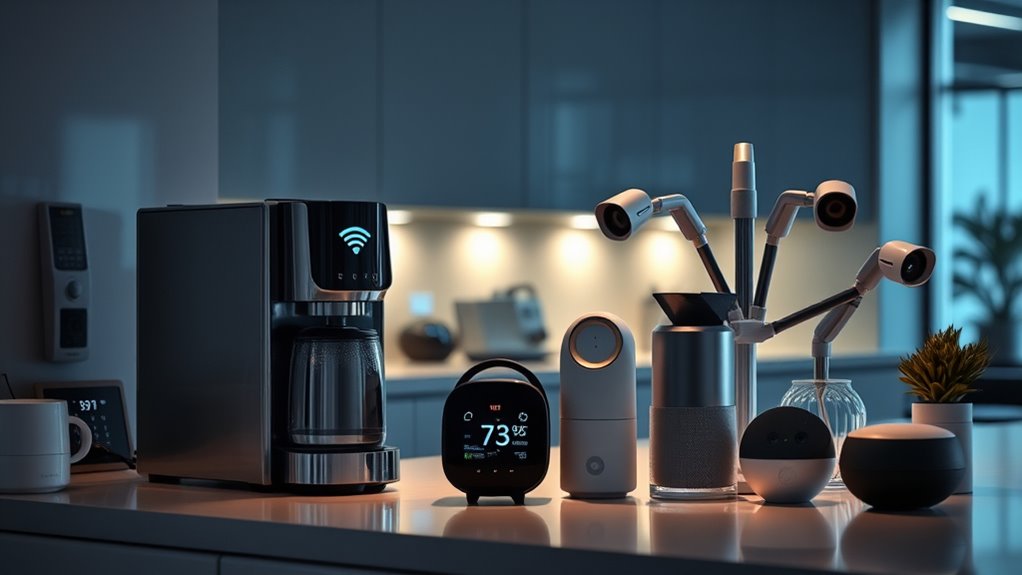Securing your office’s IoT devices, including smart coffee machines, is essential to prevent vulnerabilities that can lead to data breaches, safety issues, and operational disruptions. Use strong, unique passwords, regularly update firmware, and implement network segmentation to isolate IoT devices. Employ encrypted communication and enforce strict access controls. By understanding common vulnerabilities and adopting robust security strategies, you can protect your business from unexpected threats—and explore proven solutions to keep your network safe.
Key Takeaways
- Default passwords and outdated firmware on office IoT devices like smart coffee machines create significant security vulnerabilities.
- Connecting IoT devices directly to primary networks increases risks of hacking, malware spread, and safety hazards.
- Implementing strong authentication, network segmentation, and regular firmware updates are essential for securing office IoT equipment.
- Continuous device inventory, role-based access control, and network monitoring help detect and prevent potential IoT threats.
- Future security strategies include AI-driven threat detection, zero-trust models, and standardized device hardening protocols.
The Rise of IoT Devices in Modern Office Environments
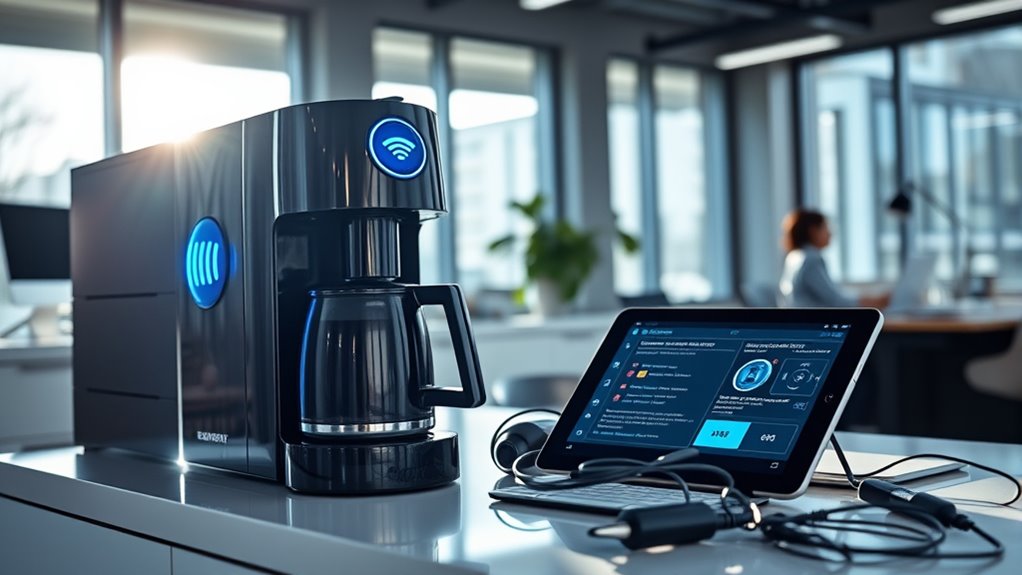
The rise of IoT devices in modern office environments is transforming how workplaces operate and improve efficiency. By the end of 2024, over 18 billion connected devices will be in use globally, with growth rates around 13% annually. This rapid expansion reflects companies’ efforts to automate and optimize operations, pushing the total number of IoT devices to more than 75 billion by 2025. Offices are adopting smart sensors, environmental controls, and connected equipment like printers, security systems, and even coffee machines. These devices provide convenience and data insights but also introduce new challenges. As organizations invest over a trillion dollars into IoT markets, they must prepare for scalability and infrastructure needs to manage this explosion of connected technology effectively. Current IoT device counts highlight the importance of implementing robust security measures to protect sensitive office networks. Additionally, the increasing reliance on interconnected devices underscores the need for effective network security protocols to prevent potential breaches and disruptions.
Common Vulnerabilities Found in Office IoT Equipment
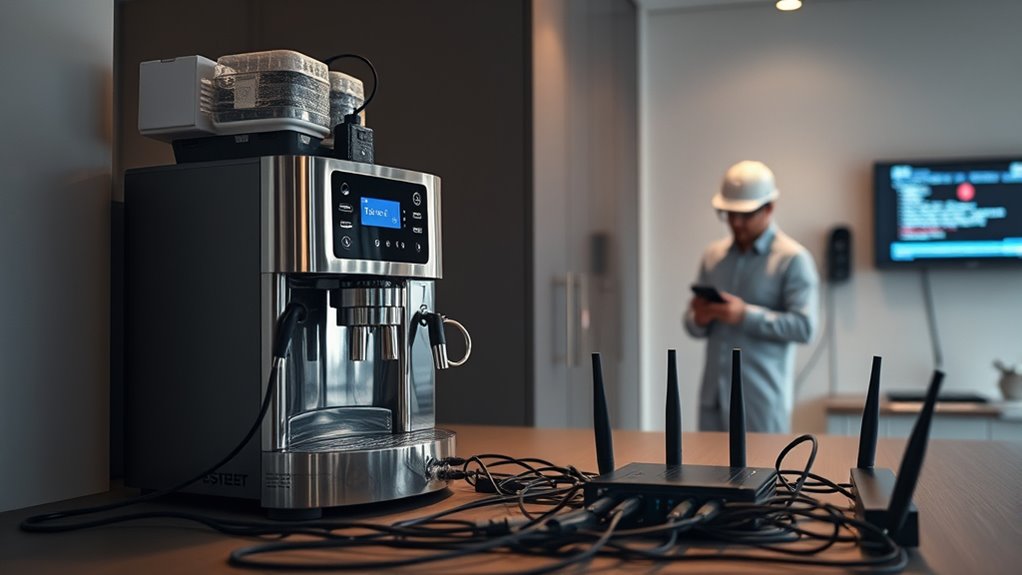
Many office IoT devices still come with default passwords, making them easy targets for hackers. Outdated firmware also leaves these devices vulnerable to known exploits that could compromise your network. Addressing these issues quickly can substantially improve your office’s overall security. Implementing security best practices such as regular updates and strong password policies can further reduce risks.
Default Passwords and Credentials
Default passwords remain one of the most common vulnerabilities in office IoT devices, leaving them open to attack if not changed promptly. Many devices still use simple default credentials like ‘admin’, ‘123456’, or ‘user’, which hackers can easily exploit. For example, over 600,000 GPS trackers with default passwords exposed sensitive location data, including children’s whereabouts. Shockingly, only about 33% of users change default passwords, leaving many devices vulnerable. Manufacturers often neglect to enforce password updates, though new regulations are starting to address this. In office environments, IoT devices like smart coffee machines and baby monitors with default credentials increase risks of unauthorized access, data breaches, and espionage. Changing default credentials is essential to protect your network and sensitive information.
Outdated Firmware Vulnerabilities
Outdated firmware in office IoT devices remains a significant security blind spot. Many devices, like smart coffee machines, run on firmware that’s several years old and full of known vulnerabilities. These outdated components expose your devices to attacks, with over half of global IoT devices suffering from critical, unpatched flaws. Attackers can exploit issues like buffer overflows, weak authentication, and unverified firmware updates to inject malicious code. Since firmware often lacks secure boot or cryptographic signing, malicious modifications go unnoticed. Delayed updates and vendor support gaps leave devices vulnerable longer. Research indicates that many IoT devices continue to run outdated firmware, significantly increasing their attack surface. This expands the attack surface, enabling malware spread and lateral network movement. Unpatched firmware vulnerabilities are a common security concern that can be exploited if not addressed promptly. Without timely firmware management, your office’s IoT ecosystem remains open to exploitation, risking data breaches, operational disruption, and compromised security.
The Risks of Overlooking Smart Coffee Machines and Peripherals
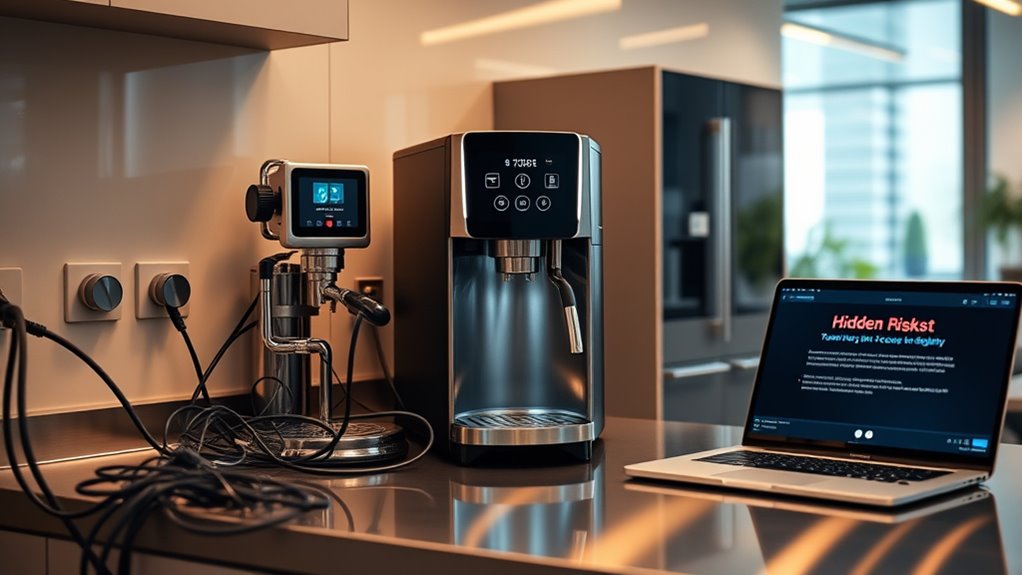
While smart coffee machines may seem like convenient office amenities, overlooking their security risks can expose your network to serious threats. These devices can serve as entry points for hackers, risking data breaches and malware spread across your network. Connecting them to primary networks increases the chance of malfunctions, safety hazards, and even physical damage, like overheating or fires. Many smart coffee machines lack robust security features, making them vulnerable to exploitation. If compromised, they can disrupt operations, lead to costly incidents, or damage your company’s reputation. Additionally, poorly secured peripherals expand your attack surface, especially when staff are unaware of potential risks. Ignoring these vulnerabilities leaves your entire office environment exposed to cyberattacks and physical hazards, emphasizing the need for proper security measures. Many coffee makers come with default settings, including no password for Wi-Fi connection, which further increases their vulnerability to hacking. Implementing security best practices can significantly reduce these risks and protect your network infrastructure.
Strategies for Securing Diverse Office IoT Networks

Securing your office’s diverse IoT network requires a multi-layered approach that minimizes vulnerabilities and controls access. Start by implementing strong authentication, such as multi-factor authentication, and change default credentials to unique, complex passwords. Use secure communication protocols like HTTPS and SSH to protect data in transit, and ensure firmware is regularly updated to patch security flaws. Maintain visibility by discovering all connected devices using management tools. Employ network segmentation with VLANs and firewalls to limit lateral movement and enforce strict access controls. Encrypt data both during transmission and storage, and establish clear privacy policies. Deploy intrusion detection systems and endpoint tools to monitor activities, and conduct regular security audits to identify and address vulnerabilities proactively. Additionally, regularly review and update security policies to adapt to evolving threats and ensure comprehensive protection.
Navigating Compliance and Policy Challenges in IoT Security

Managing compliance and policy challenges in IoT security requires you to address inconsistent regulations and develop tailored policies for your organization. You need real-time visibility and automation to stay compliant across multiple sites and devices. By understanding legal frameworks and implementing continuous monitoring, you can better manage risks and meet evolving standards. Establishing clear policies based on cybersecurity and operational criteria is essential for maintaining effective IoT compliance. Additionally, fostering digital literacy among staff ensures they understand the importance of adhering to security protocols and can respond appropriately to emerging threats.
Regulatory Compliance Challenges
Regulatory compliance in IoT security presents significant challenges because devices must meet diverse and often complex legal requirements across different countries. You need to navigate varied frameworks like CE in Europe, UKCA in the UK, and RCM in Australia, each with unique rules and testing protocols. Certification processes, such as RF compliance, demand validation of emission limits, antenna tuning, and coexistence, often on a country-by-country basis. Managing compliance becomes even more complicated with multi-site deployments across multiple jurisdictions, increasing the workload and risk of errors. Additionally, evolving regulations related to cybersecurity and data privacy constantly reshape requirements, making compliance an ongoing effort. These processes are time-consuming and resource-intensive, often taking months and requiring coordination among multiple stakeholders. Global standards and localized regulations further complicate compliance management, requiring companies to adapt their processes for each target market. Staying current with regulatory updates is crucial to avoid penalties and ensure ongoing compliance.
Policy Implementation Strategies
Implementing effective IoT security policies requires a thorough approach that addresses both technical and organizational challenges. You need to maintain a continuous inventory of all IoT devices, ensuring visibility across the network, including smart coffee machines. Gaps in discovery might indicate missing firewall coverage or DHCP issues, so adjust your infrastructure accordingly. Prioritize mission-critical devices based on their business impact, and verify device profiles for accuracy. Apply zero trust principles to all devices, enforcing strong authentication and role-based access controls. Regularly patch firmware and software, and use secure over-the-air updates to keep devices current. Monitor network traffic continuously, automate threat detection, and integrate with enterprise security systems. Research required for custodian services to ensure proper management and compliance. Clear policies, staff training, and accountability are essential to sustain robust IoT security across your organization. Additionally, conducting ongoing assessments to discover devices not yet identified by your security tools ensures comprehensive coverage and reduces potential blind spots by conducting regular network scans and device audits.
Future Trends and Innovations in Office IoT Security
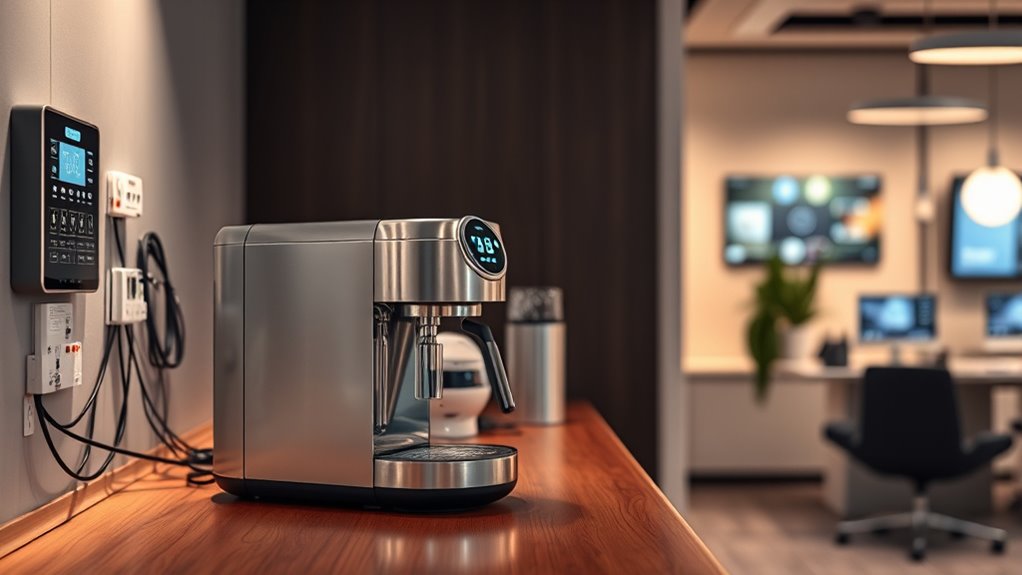
As office IoT security continues to evolve, future trends focus on integrating advanced frameworks and innovative technologies to safeguard connected devices. You’ll see more businesses adopting zero-trust models, which enforce least-privilege access and layer security from hardware to software. AI-based anomaly detection will automate real-time threat responses, reducing manual oversight. Biometrics and touchless authentication, like facial recognition and encrypted fingerprint keys, will replace passwords, boosting security and convenience. IoT device hardening will become standard, with stronger credentials, regular updates, and compliance with new global regulations. Pre-registration portals and automated visitor management will streamline physical access, minimizing social engineering risks. Additionally, automated threat detection and response—using self-healing hardware and in-memory breach detection—will be essential for maintaining security amidst increasing cyber threats. Implementing home improvement strategies such as regular assessments and proactive organization can also enhance overall security posture by reducing clutter and vulnerabilities.
Frequently Asked Questions
How Can I Identify Unknown Iot Devices on My Office Network?
To identify unknown IoT devices on your office network, start by running network scanning tools like Nmap or wireless scanners to detect connected devices. Use commands like `arp -a` and `ping -a` to find device IPs and hostnames. Monitor network traffic with tools like NetFlow or SNMP, and compare MAC addresses against known device lists. Regular scans and network segmentation help keep your network secure from unidentified devices.
What Are Best Practices for Training Staff on Iot Security Awareness?
Imagine your team as vigilant guards, each equipped with a flashlight, ready to spot security risks. To train staff effectively, you should run regular sessions on IoT threats, secure device setup, and recognizing social engineering tricks. Use real-world scenarios to keep them engaged. Foster open communication, encourage questions, and promote a security-first mindset. Consistent training guarantees everyone knows how to spot vulnerabilities and respond swiftly, keeping your network safe.
How Do Iot Vulnerabilities Differ Between Office and Industrial Environments?
You should understand that IoT vulnerabilities vary between office and industrial setups. In offices, devices like smart coffee machines have fewer security features and are easier to target for lateral attacks, risking privacy breaches. Industrial environments, however, face more complex threats that could cause physical damage or operational disruptions, often due to less visible or outdated legacy systems. Recognizing these differences helps you tailor your security measures effectively.
What Role Does AI Play in Detecting Iot Security Breaches?
Think of AI as your security guard, constantly watching over your IoT devices. It detects breaches by spotting anomalies—like noticing a coffee machine suddenly drinking more water than usual. AI uses machine learning and deep learning to analyze data in real-time, catching threats early. This proactive approach helps prevent attacks before they escalate, keeping your network safe and ensuring your IoT ecosystem remains secure and reliable.
How Can Small Businesses Afford Comprehensive Iot Cybersecurity Measures?
To afford extensive IoT cybersecurity, you should prioritize your critical assets and focus on cost-effective solutions. Outsource security services or partner with vendors to reduce expenses. Implement basic security practices like strong passwords and regular updates. Consider cyber insurance to offset potential costs from breaches. By streamlining your budget and staying vigilant with simple measures, you can enhance your IoT security without overspending.
Conclusion
As you embrace the IoT revolution in your office, remember that each connected device is a potential open door for threats. Think of your network as a garden—you must tend it carefully, pruning vulnerabilities and nurturing strong security practices. By staying vigilant and proactive, you’ll turn your office into a fortress rather than a house of cards, ensuring your smart devices work for you, not against you. Secure today to safeguard tomorrow’s innovations.
